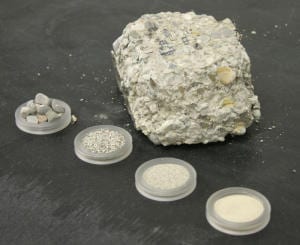Every year several millions of tons of building rubble are produced.
An efficient way of recycling concrete – the building material of the 20th and 21st century – does not yet exist. Researchers are working on new recycling methods, and with the aid of lightning bolts, they can break down the mixture of cement and aggregate into its components.
Whether the Pantheon in Rome or the German concrete canoe regatta, whether ultra-light or decorative: concrete is unbelievably versatile and is the world’s most widely used material – next to water. It is made of cement, water and aggregate, a mixture of stone particles such as gravel or limestone grit in various sizes. However, the CO2 emissions, which are mainly the result of cement production, are problematic: the production of one ton of burned cement clinker of limestone and clay releases 650 to 700 kilograms of carbon dioxide. This means that every year 8 to 15 percent of global CO2 production is attributable to concrete manufacturing. And when it comes to recycling waste concrete, there is no ideal solution for closing the materials loop. In Germany alone the quantity of construction waste amounted to almost 130 million tons in 2010.
“This is an enormous material flow, but at the moment there is no effective recycling method for concrete rubble” explains Volker Thome from the Fraunhofer Institute for Building Physics IBP from the Concrete Technology Group in Holzkirchen. The current method is to shred the concrete, which produces huge amounts of dust. At best, the stone fragments end up as sub-base for roads. “This is downcycling,” explains Thome, in other words, simply the reutilization of raw materials, the quality of which deteriorates from process to process. On the other hand, if it were possible to separate the stone particles from the cement stone, the gravel could easily be reused as an aggregate in new cement – a first decisive step in the direction of recycling waste concrete. “The recovery of valuable aggregate from waste concrete would multiply the recycling rate by a factor of around ten and thereby increase it to 80 percent,” says Thome. If it were also possible to obtain a cement substitute from waste concrete, the cement industry’s CO2 emissions would be considerably reduced. To achieve these goals Thome revived a method that Russian scientists already developed in the 1940s then put on ice: electrodynamic fragmentation. This method allows the concrete to be broken down into its individual components – aggregate and cement stone.
Recycling valuable components
Using this approach, the researchers in Holzkirchen are unleashing a veritable storm of lightning bolts.
via Fraunhofer & AlphaGalileo
The Latest Streaming News: Recycle Concrete updated minute-by-minute
Bookmark this page and come back often
Latest NEWS
Latest VIDEO








